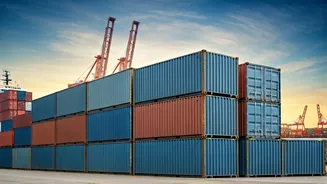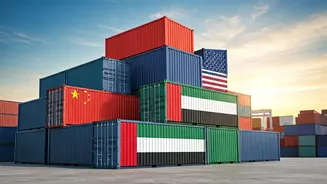Trade Relationship Under Strain
According to a GTRI report, India's exports to the United States experienced a dramatic downturn. Over a four-month period, the decline reached a substantial
37.5%. This drop is largely attributed to the imposition of tariffs, which have significantly altered the dynamics of trade between the two nations. These tariffs have made Indian goods more expensive in the US market, consequently diminishing their competitiveness. This has led to a reduction in demand and a subsequent decrease in the volume of exports. The report highlights the sensitivity of international trade to such policy changes, showcasing how quickly trade flows can be affected by financial or economic adjustments. The substantial decrease underscores the significance of maintaining stable trade relations and the potential adverse effects of protectionist measures.
Tariffs' Impact Detailed
The primary driver behind the 37.5% reduction in Indian exports to the US is the imposition of tariffs. These duties, essentially taxes on imported goods, have directly increased the cost of Indian products for American consumers and businesses. This price hike has reduced the attractiveness of Indian goods compared to domestically produced or tariff-free alternatives. As a result, businesses and consumers have scaled back their purchases of Indian products, causing a decline in export volumes. This effect is particularly pronounced in sectors where the tariff increases are significant, affecting a broad spectrum of products. The GTRI report's findings underscore the negative repercussions of trade barriers and their ability to disrupt established trade patterns, leading to substantial economic consequences for the involved nations.
Economic Ramifications Explored
The significant decrease in exports has broader economic implications for both India and the US. For India, a decline in exports can lead to a decrease in manufacturing output, job losses in export-oriented industries, and a reduction in foreign exchange earnings. This can, in turn, affect India's economic growth and overall financial stability. The US also faces repercussions, as it may experience higher prices for the affected goods. Additionally, the decline in imports from India may disrupt supply chains and potentially increase production costs for US businesses that rely on Indian raw materials or intermediate goods. This situation can affect consumer prices and reduce the variety of available products. The decline of 37.5% highlights the interconnectedness of global economies and the potential for trade policies to create ripple effects that influence industries and consumers across borders.
GTRI Report's Insights
The GTRI report offers valuable insights into the current state of Indo-US trade relations. It not only quantifies the impact of tariffs but also provides a detailed analysis of the underlying causes and potential consequences. The report likely examines the specific sectors most affected by the tariffs, providing a granular view of the impact on various industries. Further, it may evaluate potential strategies to mitigate the negative effects of the trade barriers. This might include exploring alternative trade agreements, diversifying export markets, or lobbying for changes in US trade policies. The GTRI report's findings serve as an important resource for policymakers, businesses, and researchers seeking to understand and respond to the evolving trade environment between India and the United States.
Future Outlook Considered
Looking ahead, the future of Indo-US trade relations will depend on several factors, particularly the evolution of tariff policies. If tariffs persist, the downward trend in Indian exports may continue, necessitating proactive measures to address the situation. Both governments could pursue diplomatic channels to negotiate tariff reductions or explore alternative trade arrangements that promote balanced and equitable commerce. Businesses may adapt by seeking other markets or diversifying their product offerings to minimize risk. Furthermore, the economic dynamics of both nations will continue to influence their trade relationship, making it essential to monitor economic indicators and adjust strategies to achieve sustainable trade growth. The interplay of political decisions, economic developments, and business strategies will shape the trajectory of trade relations between India and the US in the years to come.












